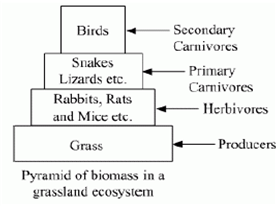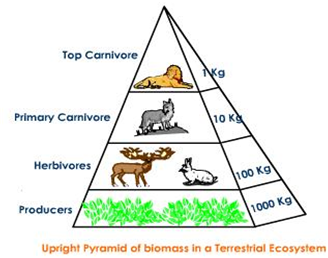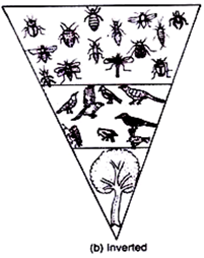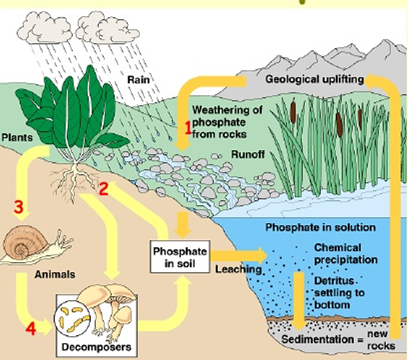(a) Explain the significance of ecological pyramids with the help of an example.
(b) Why are the pyramids referred to as upright or inverted?(a) Ecological pyramid is defined as a graphic presentation of the ecological functions like the number of individuals in the various trophic levels, the amount of biomass or the transfer of energy at different trophic levels. This give an apparently simple and fundamental basis for comparing: different ecosystems, seasonal variation within a particular ecosystem, change in an ecosystem. The size of the portion of the diagram associated with each trophic level illustrates the amount of energy, biomass, or number of individuals found in each trophic level.
There are three types of pyramids:
1. Pyramid of numbers- which represents the numbers of organisms at each trophic level.
2. Pyramid of biomass- which represents the weight (usually dry weight) or biomass of organisms at each trophic level.
3. Pyramid of energy - which monitor the energy content of the organisms at each trophic level.
For example - the pyramid of biomass in grassland ecosystem- The producers occupy the base which denotes that the biomass of producer is the highest. The herbivores like rabbits, rats etc. occupy the second trophic level followed by primary carnivores like snakes and lizards. The secondary carnivores occupy the last trophic level and have the lowest biomass.
(b) Upright pyramids - The base of most pyramid (pyramids of number, energy and biomass), representing the producers or the first trophic level is broad and it narrows down at the apex. These pyramids are called upright pyramids. It means producers are more in number and in biomass than the herbivores, and herbivores are more in number and biomass than the carnivores. Also energy at a lower trophic level is always more than that at a higher level.
Inverted pyramids - are those in which the base is narrow and the apex is broad. It denotes that the number or biomass at the first trophic level or producer level is lower as compared to the higher trophics like herbivores or carnivores. These are inverted pyramids. For example- large number of insects feeding on a big tree gives an inverted pyramid of number. The pyramid of biomass in sea is also generally inverted because the biomass of fishes far exceeds that of phytoplankton.
(a) Taking an example of a small pond explain how the four components of an ecosystem function as a unit.
(b) Name the type of food chain that exists in a pond.
(a) The pond ecosystem is fairly a self-sustainable unit.
A pond is a shallow water body in which all the above mentioned four basic components of an ecosystem are well exhibited.
The abiotic component is the water with all the dissolved inorganic and
organic substances and the rich soil deposit at the bottom of the pond.
The solar input, the cycle of temperature, day-length and other climatic
conditions regulate the rate of function of the entire pond.
The autotrophic components include the phytoplankton, some algae and the floating,
submerged and marginal plants found at the edges.
The consumers are represented by the zooplankton, the free swimming and bottom dwelling forms.
The decomposers are the fungi, bacteria and flagellates especially
abundant in the bottom of the pond.
This system performs all the functions of any ecosystem and of the biosphere as a whole, i.e., conversion of inorganic into organic material with the help of the radiant energy of the sun by the autotrophs;
consumption of the autotrophs by heterotrophs;
decomposition and mineralisation of the dead matter to release them back
for reuse by the autotrophs.
(b) In the pond ecosystem the Grazing Food Chain is the major food chain for the energy flow. 
Discuss the role of healthy ecosystem services as a prerequisite for a wide range of economic, environmental and aesthetic goods and services.
Ecosystem services are the products of ecosystem processes. Forests are the major source of ecosystem services and are
prerequisite for environmental, aesthetic goods and indirect economic values in the following ways:
1. Environmental Values
(i) Carbon-fixation Huge amount of CO2 in the atmosphere is removed naturally and fixed by plants into organic
molecules and energy through photosynthesis. All the other trophic levels, i.e. consumers depend upon this
energy produced by them.
(ii) Release of oxygen by the producers as a byproduct in the process of photosynthesis, improves the air quality
and supports life on earth.
(iii) Soil Soil formation and soil protection are the major ecosystem services accounting for nearly 50% of their total
worth. Plant cover protects the soil from drastic changes in temperature. There is little wind or water erosion as
soil particles are not exposed to them. The soil remains spongy and fertile. There are not landslides and no floods.
(iv) Nutrient cycling There is no depletion of nutrients, but the same are repeatedly circulated.
2. Economic Value
(i) Ecosystem services provide certain economical important products also. These include timber, paper, rubber,
wax, medicines, cosmetics, resins, etc.
(ii) Ecosystem also provides other benefits such as aid in pollination. Bees and other insects of natural ecosystem visit
nearby farmlands to pollinate crops.
3. Other aesthetic values Natural ecosystems are a source of spiritual, cultural and aesthetic values.
Give a graphic representation of carbon cycle in nature.

â–² Fig. 6.7 Carbon cycle in nature.
1. The natural reservoir of phosphorus is rock in the form of phosphates.
2. Minute quantities of phosphates get dissolved in the soil solution during weathering of rocks.
3. Phosphates enter the plants through their roots and then the food chain.
4. The organic wastes and dead organisms are decomposed by phosphate-solubilising bacteria, which release phosphorus back in the soil.
5. The atmospheric input of phosphorus through rainfall or gaseous exchange of phosphorus between organisms and environment, is negligible.
Phosphorus Cycle
